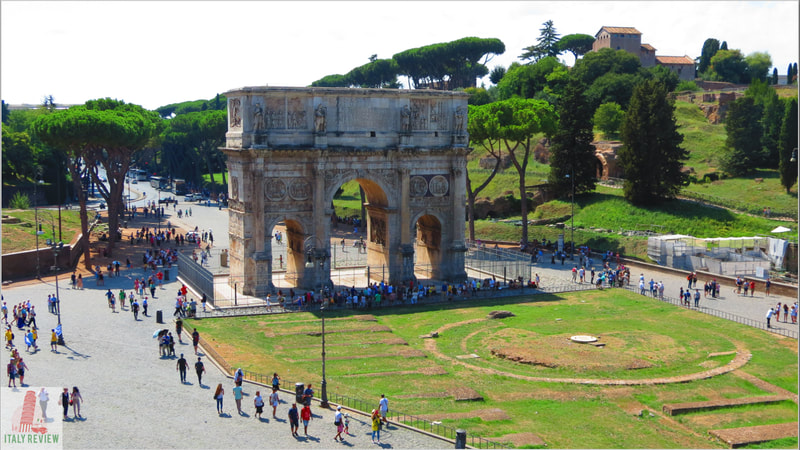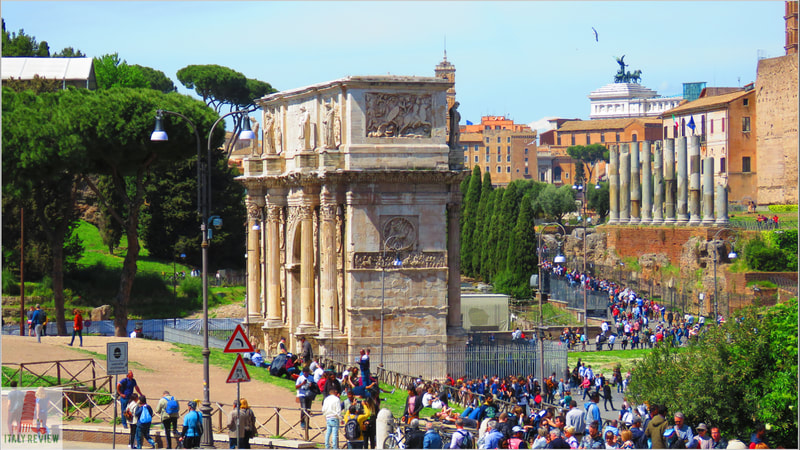Arch of Constantine
|
By Dion Protani
|
Latest update: 23 January 2024
|
|
The Arch of Constantine is a triumphal arch situated in the centre of Rome. Named after the Emperor Constantine, it was built to honour his success in the 312 AD Battle of the Milvian Bridge. The arch itself was finally completed on 25th July 315 AD.
It stands 21 metres high and lies between two of Rome's most famous monuments: the Colosseum and the Roman Forum. |
Related links
Profile
The Arch of Constantine is an impressive triumphal arch located in Rome, Italy. It stands near the Colosseum and is one of the most well-preserved and iconic Roman arches in the city.
History
The Arch of Constantine was built in AD 315 to commemorate the victory of the Roman Emperor Constantine I (Constantine the Great) over Maxentius at the Battle of Milvian Bridge in AD 312.
The victory was a pivotal moment in Roman history as it marked the beginning of Constantine's rise to power and his subsequent conversion to Christianity. The arch was strategically placed at the entrance to the Roman Forum, ensuring its prominence as a symbol of military triumph and political power.
The victory was a pivotal moment in Roman history as it marked the beginning of Constantine's rise to power and his subsequent conversion to Christianity. The arch was strategically placed at the entrance to the Roman Forum, ensuring its prominence as a symbol of military triumph and political power.
Key features and nearby attractions
- Architecture: The arch is a fine example of Roman triumphal arch architecture. It stands about 21 meters (69 feet) tall and is decorated with intricate reliefs and sculptures, many of which were taken from earlier monuments and reused in the construction of the arch.
- Reliefs: The arch's reliefs depict scenes from Constantine's military campaigns, including the Battle of Milvian Bridge, as well as scenes of Roman sacrifice and victory. Some of the reliefs were adapted from older monuments, adding a fascinating layer of historical significance to the arch.
- Accessibility: The Arch of Constantine is located near the Colosseum, making it easily accessible on foot or by public transportation. It is a part of the historical center of Rome and is surrounded by other famous landmarks and ancient ruins.
- Free Admission: There is no admission fee to see the arch, so it's a great spot for budget travelers and history enthusiasts.
- Photography: The arch offers excellent photo opportunities, especially with the Colosseum in the background. It's a popular spot for capturing the grandeur of ancient Roman architecture.
- Nearby Attractions: The arch is located within walking distance of many other notable Roman sites, including the Colosseum, Roman Forum, Palatine Hill, and the Capitoline Hill.
- Guided Tours: While the arch itself does not require a guided tour, joining a walking tour that includes the Colosseum and other nearby landmarks can provide deeper insights into the history and significance of the arch and the surrounding area.
Arco di Costantino
|
City: Rome
Province: Metropolitan City of Rome Region: Lazio Completed: 315 AD Height: 21 metres Nearest Metro stop: Colosseo - Line B - 400 m - 5 minute walk Fly to: Rome Fiumicino Airport - 27 minutes by car (29 km) Close by: Colosseum, Roman Forum, Il Vittoriano, Piazza Venezia Recommended accommodation: Hotel Artemide |
UNESCO World Heritage Site
Historic Centre of Rome, the Properties of the Holy See in the City Enjoying Extraterritorial Rights and San Paolo Fuori le Mura
Year: 1980
Historic Centre of Rome, the Properties of the Holy See in the City Enjoying Extraterritorial Rights and San Paolo Fuori le Mura
Year: 1980























